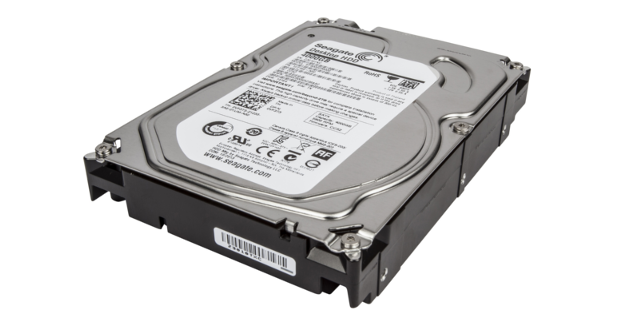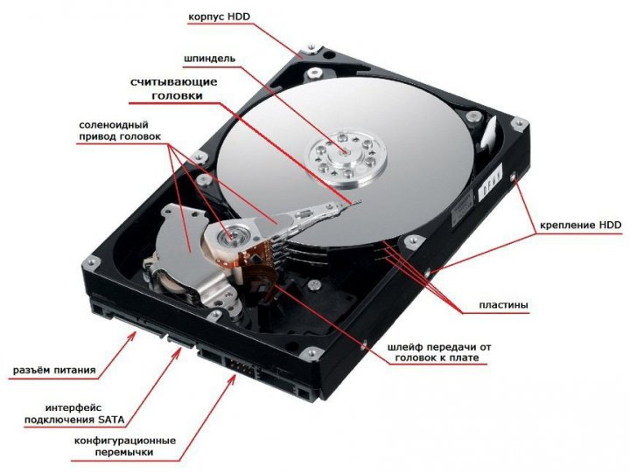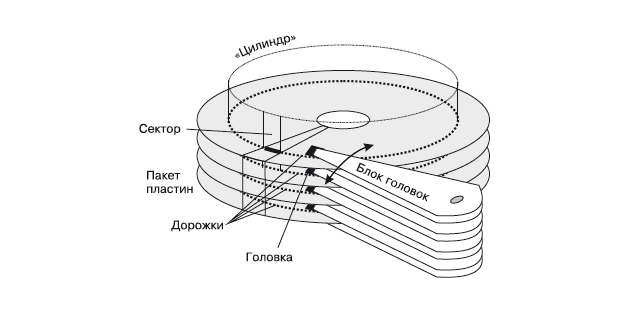What is a computer hard drive?
During computer startup, a set of firmware stored in the BIOS chip checks the hardware. If everything is in order, it transfers control to the operating system loader. Then the OS loads and you start using the computer. At the same time, where was the operating system stored before turning on the computer? How did your essay that you wrote all night stay intact after turning off the power of the PC? Again, where is it kept?
Okay, maybe I've gone too far and you all know very well that computer data is stored on a hard drive. Nevertheless, not everyone knows what it is and how it works, and since you are here, we conclude that we would like to know. Well, let's find out!
What is a hard drive
By tradition, let's look at the definition of a hard drive on Wikipedia:
HDD (screw, hard drive, hard disk drive, HDD, HDD, HMDD) is a random access storage device based on the principle of magnetic recording.
They are used in the vast majority of computers, as well as separately connected devices for storing backup copies of data, as file storage, etc.
Let's figure it out a little. I like the term hard disk drive ". These five words convey the whole point. HDD is a device whose purpose is to store data recorded on it for a long time. HDDs are based on hard (aluminum) disks with a special coating, on which information is recorded using special heads.
I will not consider in detail the recording process itself - in fact, this is the physics of the last grades of the school, and I am sure you have no desire to delve into this, and the article is not about that at all.
Also note the phrase: random access ” which, roughly speaking, means that we (computer) can read information from any section of the railway at any time.
It is important that the HDD memory is not volatile, that is, it does not matter whether the power is connected or not, the information recorded on the device will not disappear anywhere. This is an important difference between a computer's permanent memory and temporary ().
Looking at a computer hard drive in real life, you will not see any disks or heads, since all this is hidden in a sealed enclosure (hermetic zone). Externally, the hard drive looks like this:

Why does a computer need a hard drive?
Consider what an HDD is in a computer, that is, what role it plays in a PC. It is clear that it stores data, but how and what. Here we highlight the following functions of HDD:
- Storage of OS, user software and their settings;
- Storage of user files: music, video, images, documents, etc.;
- Using part of the hard disk space to store data that does not fit in RAM (paging file) or storing the contents of RAM while using sleep mode;
As you can see, a computer hard drive is not just a dump of photos, music and videos. It stores the entire operating system, and in addition, the hard drive helps to cope with the workload of RAM, taking on some of its functions.
What is a hard drive made of?
We partially mentioned the components of the hard drive, now we will deal with this in more detail. So, the main components of the HDD:
- Frame Protects hard drive mechanisms from dust and moisture. As a rule, it is airtight so that the same moisture and dust do not get inside;
- Disks (pancakes) - plates made of a certain metal alloy, coated on both sides, on which data is recorded. The number of plates can be different - from one (in budget options) to several;
- Engine - on the spindle of which pancakes are fixed;
- Head block - a design of interconnected levers (rocker arms), and heads. The part of a hard drive that reads and writes information to it. For one pancake, a pair of heads is used, since both the upper and lower parts of it are working;
- Positioning device (actuator ) - a mechanism that drives the block of heads. Consists of a pair of permanent neodymium magnets and a coil located at the end of the head unit;
- Controller - an electronic microcircuit that controls the operation of the HDD;
- parking zone - a place inside the hard drive next to the disks or on their inside, where the heads are lowered (parked) during downtime, so as not to damage the working surface of the pancakes.

Such a simple hard drive device. It was formed many years ago, and no fundamental changes have been made to it for a long time. And we move on.
How a hard drive works
After power is supplied to the HDD, the engine, on the spindle of which the pancakes are fixed, begins to spin up. Having gained a speed at which a constant stream of air is formed near the surface of the discs, the heads begin to move.
This sequence (first the discs spin up, and then the heads start working) is necessary so that the heads hover over the plates due to the resulting air flow. Yes, they never touch the surface of the disks, otherwise the latter would be instantly damaged. However, the distance from the surface of the magnetic platters to the heads is so small (~10 nm) that you cannot see it with the naked eye.
After starting, first of all, service information about the state of the hard disk and other necessary information about it, located on the so-called zero track, is read. Only then does the work with the data begin.
Information on the computer's hard drive is recorded on tracks, which, in turn, are divided into sectors (such a pizza cut into pieces). To write files, several sectors are combined into a cluster, which is the smallest place where a file can be written.
In addition to such a "horizontal" partitioning of the disk, there is also a conditional "vertical" one. Since all heads are combined, they are always positioned over the same track number, each over its own disc. Thus, during the operation of the HDD, the heads, as it were, draw a cylinder:

While the HDD is working, in fact, it performs two commands: reading and writing. When it is necessary to execute a write command, the area on the disk where it will be performed is calculated, then the heads are positioned and, in fact, the command is executed. The result is then checked. In addition to writing data directly to disk, information also ends up in its cache.
If the controller receives a read command, first of all, it checks for the presence of the required information in the cache. If it is not there, the coordinates for positioning the heads are calculated again, then the heads are positioned and read the data.
After completion of the work, when the power supply of the hard drive disappears, the heads are automatically parked in the parking zone.
This is how a computer hard drive works in general terms. In reality, everything is much more complicated, but the average user, most likely, does not need such details, so we will finish this section and move on.
Types of hard drives and their manufacturers
Today, there are actually three main manufacturers of hard drives on the market: Western Digital (WD), Toshiba, Seagate. They fully cover the demand for devices of all types and requirements. The rest of the companies either went bankrupt, or were taken over by someone from the main three, or re-profiled.
If we talk about the types of HDD, they can be divided in this way:
- For laptops, the main parameter is the device size of 2.5 inches. This allows them to be compactly placed in the laptop case;
- For PC - in this case, it is also possible to use 2.5 ″ hard drives, but as a rule, 3.5 inches are used;
- External hard drives are devices that are separately connected to a PC / laptop, most often acting as file storage.
There is also a special type of hard drives - for servers. They are identical to conventional PCs, but may differ in interfaces for connection, and greater performance.
All other divisions of HDD into types come from their characteristics, so we will consider them.
Hard drive specifications
So, the main characteristics of a computer hard drive:
- Volume - an indicator of the maximum possible amount of data that can be accommodated on the disk. The first thing they usually look at when choosing an HDD. This figure can reach 10 TB, although 500 GB - 1 TB is more often chosen for a home PC;
- Form factor - the size of the hard drive. The most common are 3.5 and 2.5 inches. As mentioned above, 2.5″ in most cases are installed in laptops. They are also used in external HDDs. 3.5″ is installed on the PC and on the server. The form factor also affects the volume, as more data can fit on a larger disk;
- Spindle speed - How fast do pancakes rotate? The most common are 4200, 5400, 7200 and 10000 rpm. This characteristic directly affects the performance, as well as the price of the device. The higher the speed, the greater both values;
- Interface - method (connector type) of connecting the HDD to the computer. The most popular interface for internal hard drives today is SATA (older computers used IDE). External hard drives are usually connected via USB or FireWire. In addition to those listed, there are other interfaces such as SCSI, SAS;
- Buffer volume (cache memory) - a type of fast memory (by type of RAM) installed on the HDD controller, designed for temporary storage of data that is most often accessed. The buffer size can be 16, 32 or 64 MB;
- Random access time - the time during which the HDD is guaranteed to write or read from any part of the disk. It fluctuates from 3 to 15 ms;
In addition to the above characteristics, you can also find indicators such as.






